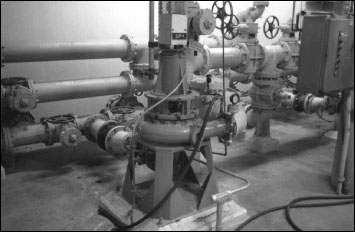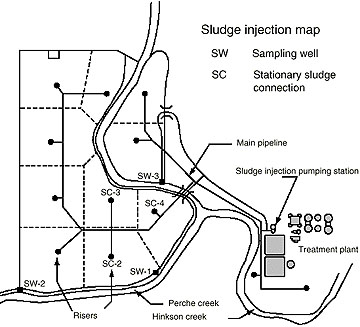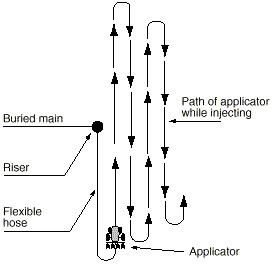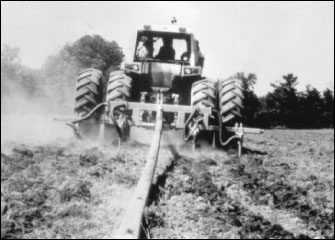Biosolids are a product of the municipal wastewater treatment process. Biosolids typically contain minerals and organic matter that can be beneficial to the soil and crop environment, and to the general tilth of the soil. See MU publications WQ428 and WQ430 for detailed information on nutrient content and agronomic considerations for applying biosolids to crops. This publication discusses equipment commonly used when biosolids are applied "on-site" on land near the wastewater treatment plant.
Biosolids characteristics
The physical characteristics of biosolids influence the type of handling equipment needed. Liquid biosolids resulting from the treatment of municipal sewage have a dry matter content of 3 percent to 6 percent. This type of biosolids is a somewhat viscous fluid (similar to a chocolate malt) and can be handled hydraulically by pumps, pipelines and applicators designed for this type material.
Biosolids that are further dewatered by filter or press (also referred to as cake biosolids) may contain up to 40 percent dry matter. This type of biosolids is handled by mechanical loading, hauling and spreading equipment. The obvious advantage of the drier biosolids is the significant reduction in water volume, which in turn reduces handling costs.
Land application of biosolids
Land application of biosolids usually is accomplished using one of two procedures. These procedures are referred to commonly as off-site and on-site methods.
On-site management of biosolids involves pumping biosolids to an adjacent land area for land application. Limitations of this procedure include the distance that the biosolids can be pumped feasibly through an underground piping system and the high initial cost for equipment and land for spreading. The generating facility normally purchases and owns the land for on-site application. Advantages include the relatively high rate (tons per day) at which biosolids can be land applied, hydraulic movement (no hauling) of biosolids and low labor requirements.
Equipment for on-site management of biosolids
In the on-site process, biosolids are pumped from the treatment plant directly to the land application site via appropriately designed pumps and underground pipeline systems.
Figure 1 is an example of a pump station used to pump biosolids to an on-site application area. Because biosolids typically may be pumped several thousand feet at a relatively high flow rate, often with an increase in elevation, these pumps have significant power, flow and pressure requirements. Flow rates of 500 gallons to 1,000 gallons per minute at pressures of 50 pounds per square inch to 100 pounds per square inch are typical. These pumps are usually electric and are in the range of 50 horsepower to 100 horsepower.
 Figure 1
Figure 1
Large electric pumps are used to transfer biosolids to the field in on-site operations.
In this pipeline process, biosolids are pumped from the treatment plant through an underground pipeline system to the land application area. Pipe size depends upon flow rate, acceptable friction loss and other factors, but usually ranges from 8 inches to 12 inches in diameter. The pipeline system must be configured with risers, which feed the biosolids into the on-site applicator. Because the applicator can only cover a limited area around each riser, several appropriately spaced risers are usually required to provide full coverage of a land application site. Figure 2 is a schematic of a typical pipeline system with risers. Depending upon field and site restrictions, each riser may be capable of serving 10 acres to 20 acres.
 Figure 2
Figure 2
Schematic layout of pipeline and risers for an on-site biosolids operation.
Land application in the pipeline process is accomplished by a knife or injection tool bar mounted on a tire or track-type power unit. This unit is fed by a flexible hose that carries the biosolids from the riser to the applicator. This hose is made of a high-strength material because it must be dragged over the ground during the land application process. Hose diameters of 4 inches to 5 inches and lengths of 660 feet are typical. This length allows an applicator to make a run of approximately 1,320 feet or one-fourth mile near each riser. Figure 3 is a schematic of a typical riser and flexible-hose layout.
 Figure 3
Figure 3
Schematic of flexible hose layout and travel path of applicator.
On-site applicators have significant power requirements and are usually four-wheel-drive tractors, or power units equipped with tracks. Figure 4 is an example of an injector unit pulled by a tractor. These units are capable of injecting biosolids at the rate of 400 gallons per minute to 800 gallons per minute, depending upon desired nutrient application rate and hydraulic characteristics. Because flow to these applicators is continuous, provision must be made to interrupt the flow as the unit is raised out of the ground for turning at the end of the field or run. Valves at the pumping station, operated remotely by radio control from the applicator, typically are used to stop flow in the pipeline while the applicator is turning or if it is stopped for some reason.
 Figure 4
Figure 4
On-site injection units are fed with biosolids pumped continuously from the treatment plant.
On-site application of fluid biosolids can be accomplished with irrigation equipment designed to handle thick fluids. Traveling guns with their own integral power units (no turbine or piston drive) and modified guns (no straightening vanes, powered gun rotator) have been used to spread this type of material. Traveling guns move under their own power via a winch/cable arrangement and are fed by a flexible hose from a riser similar to the applicator discussed above. The primary advantage of a traveling gun is less labor (no operator required once the run is started) and the ability to cover up to 10 acres with a single run. Traveling guns or other irrigation equipment are not often used to land-apply biosolids because of difficulty in obtaining precise nutrient application rates and because of the potential for vector transmission and runoff with surface application.
References
- City of Columbia, Columbia Wastewater Treatment Plant, Sludge Management Program.
- Missouri Department of Natural Resources, Division of Environmental Quality. Agricultural Use of Municipal Wastewater Sludge — a planning guide. January 1985.
- USEPA. Biosolids Technology Fact Sheet: Land Application of Biosolids EPA 832-F-00-064, September 2000.
- Lu, Q., He, Z. L., and Stoffell, P. J. Land Application of Biosolids in the USA: A Review. Applied and Environmental Soil Science, Volume 2012, Article ID 201462, doi:10.1155/2012/201462